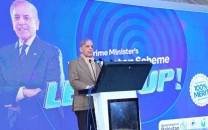A hello to cellular 5G
High-frequency 5G signals could not reach longer distances

The writer is a doctoral researcher working on advanced 5G networks at Massey University, New Zealand
The upcoming 5G of cellular technology promises to offer solution to these problems. However, how 5G will be different from its preceding generations and when, what of 5G for Pakistan is still unclear. The most publicised aspect of 5G is the introduction of new frequency spectrums, broadly categorised into frequency range 1 (FR-1) and range 2 (FR-2). FR-1 is a sub-6 GHz frequency spectrum. FR-2, on the other hand, offers very high frequency ranges (between 24 GHz to 52 GHz) to deliver unprecedented communication speeds. Recent 5G trails conducted in New Zealand have already demonstrated the speed of 9.3 Gbps over 24 GHz spectrum, nearly 10 times faster than the theoretical maximum data rate for 4G.
Merger with K-P: Internet access to FATA people urged
As a rule of thumb, higher frequencies offer higher data rate but the laws of physics dictate that greater the frequency of wireless signal, the lower it travels. It means high-frequency 5G signals could not reach longer distances.
Hence higher data rate might be achievable at the cost of lower cellular coverage. However, 5G will cater to this by some novel technological shifts. 5G envisions deploying a large number of small-sized base-stations to increase network coverage. These base-stations will be installed with advanced antennas with multiple-input-multiple-output (MIMO) technology to transmit multiple data streams, simultaneously. This way, more users will get service from a single antenna pole. Along with advanced base-stations, 5G will also offer radio spectrum for novel applications in the future. With 5G radio spectrum, fully autonomous vehicles will become a reality, ensuring safer roads. Virtual reality-based applications will soon find their ways in homes. Smartphones closer to each other will not require base-station to establish connectivity, enabling faster communication, bypassing tedious network route. Autonomous machines, home appliances, sensors, and gadgets will all connect together to form a network popularly known as the internet-of-things (IoT).
The IoT will open a new arena for smart devices with the advent of 5G. But when do we expect to actually use 5G? The commercial deployment for 5G is planned for 2020. However, South Korea has already showcased its 5G capabilities in 2018 Winter Olympics. Other countries, including the UK, the US and New Zealand have shown their 5G prowess through field trials. At the consumer end, major smartphone producers plan to launch initial 5Genabled handsets by 2019. So, what are Pakistan’s plans for 5G? In late 2017, Pakistan’s federal cabinet advised the Pakistan Telecommunication Authority (PTA) to start 5G testing in the country. The federal minister for IT, Ms Anusha Rehman, has indicated that 5G-spectrum will be available for auction in Pakistan in 2021. As for the current state of 3G/4G services, they failed to achieve popularity among the masses with less than 26% penetration. An average Pakistani does not earn high enough to pay for expensive 4G handsets, or services.
Google tries to ease tensions on eve of new EU privacy law
As a consequence, telecom operators do not generate much revenue out of 4G. Following similar trends, it is fair to say that 5G will not bring any more return-on-investment for operators. This might hinder the 5G arrival in Pakistan, at least for a few years.
However, there are certain avenues in which Pakistan can benefit ‘indirectly’ from 5G, the most important of which is the development of 5G-enabling software industry. Experts suggest that the next wave of jobs would be driven by the digital revolution, including applications of 5G services. Pakistan already has a fast-growing IT industry which provides software solution to many Western countries. A slight push in the right direction can grab major 5G-benefits for Pakistan, although actual 5G deployment still seems to be a bit far.
Published in The Express Tribune, May 28th, 2018.
Like Opinion & Editorial on Facebook, follow @ETOpEd on Twitter to receive all updates on all our daily pieces.














COMMENTS
Comments are moderated and generally will be posted if they are on-topic and not abusive.
For more information, please see our Comments FAQ